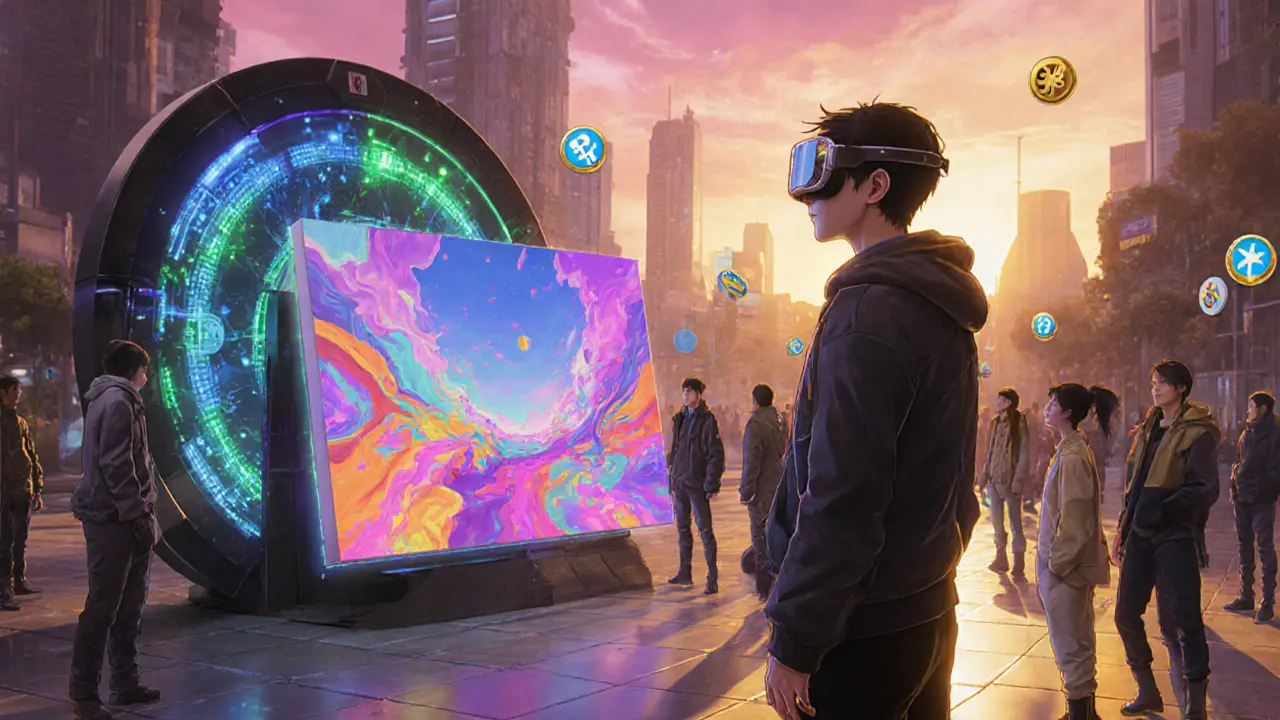NFT Value Calculator
How It Works
This calculator helps you estimate how much a creator could earn from royalties when an NFT sells. Enter the sale price and royalty percentage to see potential earnings.
Enter values and click Calculate to see estimated royalties
TL;DR
- NFTs are unique digital tokens that prove ownership of a specific item on a blockchain.
- The Ethereum network, using ERC-721 and ERC-1155 standards, is the main home for NFTs.
- Key tech pieces are smart contracts, metadata storage (often on IPFS), and royalty rules.
- Art, gaming, fashion and utility services are the biggest NFT use cases today.
- Market size is still in the tens of billions, but price swings are huge and legal rules are fuzzy.
What Exactly Is an NFT?
When you hear the term NFTs, think of a digital certificate that can’t be copied. In plain English, an NFT is a Non-Fungible Token is a unique digital asset stored on a blockchain that represents ownership of a specific item, whether that item is an image, video, piece of music, or even a real‑world object. Unlike a Bitcoin or Ether, which are interchangeable, each NFT has its own identity and cannot be split into smaller units.
How NFTs Live on a Blockchain
The backbone of every NFT is a blockchain is a decentralized, tamper‑proof ledger that records transactions across many computers. Most NFTs sit on Ethereum is a public, open‑source blockchain platform that supports programmable smart contracts and hosts the ERC‑721 and ERC‑1155 token standards because it introduced the first widely adopted standards for uniqueness.
Two standards dominate the scene:
- ERC‑721 is the original Ethereum standard for non‑fungible tokens, ensuring each token has a distinct ID.
- ERC‑1155 is a multi‑token standard that can handle both fungible and non‑fungible assets in a single smart contract, useful for gaming items that come in batches.
Core Technical Pieces
Three pieces make an NFT work:
- Smart contracts - self‑executing code on the blockchain that creates, transfers, and enforces royalty rules. A typical NFT contract includes a
mint()function to issue a new token and atransferFrom()function for sales. - Metadata - a JSON file that describes the token’s name, image URL, creator, and any extra attributes. The metadata can live on‑chain (expensive) or off‑chain via distributed storage.
- IPFS - the InterPlanetary File System, a peer‑to‑peer network that stores the actual media (image, video, 3D model) and returns a content‑addressed hash. IPFS is a decentralized file storage protocol that ensures files are immutable and can be retrieved via their unique hash.
Because the metadata hash is immutable, anyone can verify that the image hasn’t been swapped after the sale-this is the core trust mechanism.
Historic Milestones: From CryptoPunks to Today
The first major NFT project was CryptoPunks is a collection of 10,000 algorithmically generated 24‑pixel characters launched in 2017 on Ethereum, widely regarded as the first NFT series. Their success paved the way for the 2021‑2022 boom when digital art, collectibles and virtual land sold for millions.

Major Use Cases
While art grabbed headlines, NFTs now power several industries:
- Digital art - artists mint unique pieces, retain royalty percentages (typically 2.5‑10%) on every resale.
- Gaming - items like skins, weapons, or virtual land can be owned outside a single game, enabling cross‑game trading.
- Utility NFTs - tickets, membership passes, or access keys that unlock exclusive content or services.
- Fashion & collectibles - digital wearables for avatars, authenticity certificates for luxury goods.
- Real‑world tokenization - fractional ownership of property, music royalties, or even sports contracts.
Current Market Snapshot (2025)
Estimates differ, but most firms agree the NFT market sits between $40billion and $60billion in 2025. Revenue peaked at $1.58billion in 2022, fell to around $600‑$700million after the correction, and now steadies with a steady flow of utility‑focused projects. Trading volume in early 2025 slipped 24% from December 2024, reflecting broader crypto cycles.
Pros and Cons: A Quick Reality Check
| Aspect | NFT | Fungible Token |
|---|---|---|
| Uniqueness | Each token has a distinct ID | All tokens are identical |
| Divisibility | Cannot be split | Can be divided into smaller units |
| Use Cases | Art, collectibles, access rights | Payments, store of value |
| Liquidity | Often lower, market‑dependent | High, traded on most exchanges |
| Regulation | Treat‑as‑property in many jurisdictions | Varies by token type |
Benefits include provable scarcity, automated royalties, and global reach. Drawbacks are high gas fees (especially on Ethereum), environmental concerns, price volatility, and a still‑evolving legal framework around actual ownership rights.
Future Trends Shaping NFTs
Three forces will likely define the next wave:
- AI‑generated content - platforms such as Art Blocks let algorithms create unique visuals on‑the‑fly, producing endless supply of provably random art.
- Interoperability & Layer‑2 scaling - solutions like Polygon, Immutable X, and cross‑chain bridges aim to slash fees and let NFTs move between ecosystems.
- Metaverse integration - virtual worlds need verified avatars, land parcels, and collectibles; NFTs act as the passport for those assets.
As use cases broaden, we’ll see more “NFT2.0” projects that blend ownership with functional utilities (e.g., a token that grants voting rights in a DAO).
How to Get Started with NFTs
If you want to dip a toe in, follow these steps:
- Set up a crypto wallet (MetaMask, Trust Wallet, or Coinbase Wallet). Remember to back up your seed phrase!
- Buy a small amount of ETH (or the native token of your chosen chain) to cover gas fees.
- Choose a marketplace - OpenSea is one of the largest NFT marketplaces, supporting Ethereum, Polygon and other networks is a good starting point for art and collectibles.
- Connect your wallet, browse collections, and place a bid or purchase.
- After acquisition, view the token’s details: contract address, token ID, and royalty split. Most platforms show the on‑chain provenance.
Creating your own NFT is similar: upload the file, fill out metadata, set a royalty percentage, and mint. For simple drops, it can take 2‑4hours; advanced contracts may need weeks of Solidity development.
Regulatory Landscape
Governments treat NFTs as property for tax purposes in the U.S., requiring capital‑gains reporting. The EU is drafting consumer‑protection rules, while Asian regulators range from open‑innovation hubs to outright bans on speculative trading. Always check local tax guidance before selling.

Frequently Asked Questions
Are NFTs a good investment?
Investing in NFTs can be profitable if you focus on utility‑driven projects, reputable artists, or assets with real‑world ties. Pure speculation carries high risk, as prices can swing dramatically.
Do I really own the artwork I buy?
Technically you own a token that proves you hold the rights recorded on the blockchain. Copyright and the right to reproduce the image remain with the creator unless otherwise transferred in a separate contract.
What are gas fees and why are they high?
Gas fees are the transaction costs paid to miners or validators for recording an action on a blockchain. On Ethereum, demand spikes raise fees; using Layer‑2 solutions or cheaper chains can lower costs.
Can NFTs be fractionalized?
Yes. Platforms now issue fractional shares of high‑value NFTs, allowing multiple owners to hold a percentage of the original token and share any future revenue.
How do royalties work?
Smart contracts can be programmed to send a percentage of each resale (usually 2.5‑10%) automatically to the creator’s wallet. Some marketplaces let creators opt‑out, so check the platform’s policy.


Post Comments (18)
Sure, NFTs are just overpriced digital Beanie Babies 🚀
Scrolling through that guide feels like a crash course in blockchain buzzwords, but the core idea is surprisingly simple. You basically own a cryptographic receipt that says “this pixel belongs to you.” The royalty mechanics are neat, yet most newbies overlook the gas fee monster hidden behind every mint. Still, it’s a decent primer for anyone curious.
The post does a respectable job of demystifying the tech stack, yet it glosses over the sociocultural fallout of turning art into code. When you tokenize a painting, you’re not just creating a tradable asset; you’re rewriting ownership narratives that have existed for centuries. The emphasis on ERC‑721 versus ERC‑1155 is useful, but the real debate lies in whether we should even be commodifying digital expression. Moreover, the environmental critique of Ethereum, despite the migration to proof‑of‑stake, still haunts many creators. I appreciate the section on royalties, though the promised “automatic payments” can be subverted by marketplace policies. The market snapshot feels optimistic, ignoring the fact that most volume is driven by speculative flipping. Ultimately, the guide is a solid starting point, but readers should stay skeptical of hype.
If you’re feeling overwhelmed by all the jargon, take a breath and start with the basics: set up a wallet, buy a tiny amount of ETH, and explore a low‑fee marketplace like Polygon. The key is to experiment in small bites; you’ll learn more from a single successful purchase than from reading endless articles. Remember that every seasoned collector started as a beginner, so give yourself permission to make mistakes. Your curiosity is the engine that will drive deeper understanding.
Honestly, most of this guide feels like fluff dressed up as education, but hey, at least it’s colourful 😒. If you really want to know how to make money, skim past the history and start minting cheap memes.
While the article offers a well‑structured overview, it inadvertently perpetuates several misconceptions that merit correction. First, the assertion that NFTs “prove ownership” conflates possession of a token with legal title, which varies across jurisdictions and is often limited to a bundle of rights stipulated in the smart contract. Second, the emphasis on Ethereum overlooks the burgeoning ecosystems of Solana, Tezos, and Flow, each offering distinct trade‑offs in terms of scalability, environmental impact, and developer tooling. Third, the discussion of royalties fails to acknowledge that many marketplaces either truncate royalties or rebrand them as “creator fees,” thereby eroding the intended perpetual revenue stream. Fourth, the guide’s portrayal of market size as “tens of billions” neglects to account for the volatility introduced by macro‑economic shocks, such as regulatory crackdowns and sudden gas price spikes. Fifth, the technical section on IPFS is overly simplistic; nodes must pin content, and without proper pinning services the underlying asset can become inaccessible, defeating the purpose of immutability. Sixth, the suggestion that “anyone can mint in 2‑4 hours” ignores the complexities of smart‑contract audits, especially for projects that aim to handle significant financial flows. Seventh, the regulatory overview is shallow; in several jurisdictions, NFTs are classified as securities, triggering compliance obligations that the article glosses over. Eighth, the environmental critique deserves a nuanced treatment; while proof‑of‑stake reduces emissions, the energy consumption of validation nodes still contributes to the broader carbon footprint. Ninth, the claim that “royalties are automatic” is technically true on-chain but practically dependent on marketplace enforcement mechanisms. Tenth, the article does not discuss the rise of layer‑2 solutions like Immutable X, which aim to eliminate gas fees entirely for NFT transactions. Eleventh, there is no mention of the emerging standards for on‑chain metadata, such as ERC‑721A, which address scalability concerns. Twelfth, the guide omits discussion of the legal implications of derivative works minted as NFTs, a gray area that can expose creators to copyright infringement claims. Thirteenth, the notion that “NFTs are immutable” disregards that smart contracts can be upgraded via proxy patterns, potentially altering token behavior retroactively. Fourteenth, the article underestimates the importance of community governance in NFT projects, where token holders often influence roadmap decisions. Finally, while the article is accessible to novices, it would benefit from a more critical lens that interrogates the hype rather than merely cataloguing features.
Reading this guide feels like a therapy session where the therapist keeps repeating the same platitudes about “innovation” while ignoring the soul‑crushing reality of speculation. You’re told NFTs are “the future,” but the underlying market is riddled with wash‑trading and pump‑and‑dump schemes. The so‑called “royalty” feature is just a feel‑good hook that many platforms conveniently bypass. If you’re looking for genuine artistic value, you’ll have to sift through a swamp of meme‑driven junk. In short, don’t let the glossy UI lull you into a false sense of security.
Honestly, I think most people reading this are just chasing hype, but the guide does a decent job of laying out the basics without drowning you in techese. The sections on ERC‑721 vs ERC‑1155 are surprisingly clear, and the royalty breakdown is something you’ll actually use when you sell your first piece. Still, don’t be fooled into thinking NFTs are a guaranteed paycheck – the market’s as fickle as a teenager’s mood. If you want to experiment, start cheap and watch the fees bite you first. It’s a wild ride, but at least you’ll know what you’re getting into.
Start with a wallet, buy a little ETH, then explore a low‑fee marketplace. Keep your seed phrase safe.
Nice breakdown, Bobby – the “cryptographic receipt” line cracked me up 😆. I’d add that most newbies also forget to check the gas estimator before confirming. Bottom line: if the fee is higher than the NFT, you might as well buy a coffee.
Mark, your exhaustive checklist reads like a legal dissertation, yet it underscores a deeper philosophical tension: the desire to codify ownership in immutable code versus the fluidity of human creativity. By enumerating every nuance, you inadvertently reveal that the very act of “listing” an NFT is an exercise in narrative construction. Each clause you add becomes a clause in the collective mythos of digital scarcity. The paradox is that the more we try to regulate, the more we expose the system’s brittleness. Moreover, your point about on‑chain metadata standards hints at a future where provenance is as much about data integrity as about artistic intent. If we accept that smart contracts are mutable via proxies, then the sanctity of “immutability” is merely a marketing slogan. Your emphasis on regulatory compliance also raises the question of jurisdictional arbitrage: will creators migrate to friendlier legal havens? In any case, your thoroughness serves as a reminder that NFTs are not just tech toys but socio‑economic constructs demanding rigorous scrutiny. Ultimately, the conversation you spark is valuable, even if the list feels endless.
Evie, the “soul‑crushing reality” bit hits a nerve, but let’s be real – the market’s volatility is what fuels the excitement for many. If you think it’s all doom, you’re missing the adrenaline of a good flip. Maybe the guide could have highlighted that balance.
John, it’s easy to dismiss the content as fluff, but you’ll find that the practical steps – wallet setup and low‑fee platforms – are the real value. Take those pointers and give it a try.
Oreoluwa, that concise advice is spot on. A simple wallet and a bit of ETH go a long way.
Kate, love how you kept it real – “market’s as fickle as a teenager’s mood” totally nails it 😂. Just remember, even meme NFTs can surprise you.
Prince, your calm steps are exactly what beginners need – start small, learn, and grow.
celester, you raise good points about ownership narratives – maybe the future lies in hybrid models that blend digital tokens with real‑world rights.
Stefano, calling NFTs “digital Beanie Babies” might be an oversimplification – there are hidden layers of data collection and control that most users don’t see.